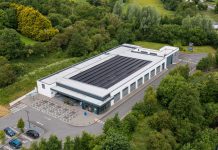London Southend Airport has demonstrated its commitment to self-generation with the largest ever installation of solar panels at a British airport.![]()
Photon Energy managing director Jonathan Bates commented: “Solar is Britain’s favourite renewable energy and it’s great London Southend Airport has shown its commitment to self-generation. You can’t necessarily see the panels from the ground but millions of people will get a bird’s eye view of them as they take off or come in to land.
“Airport terminals are great places for solar as they have a lot of roofspace and large daytime electricity consumption.”
Conergy UK & Ireland managing director Robert Goss added: “The recent flooding and heavy rain are a reminder of why the buildings we put up today should consider the climate of tomorrow and produce as much zero-carbon energy as possible.
“The British solar industry can easily turn otherwise unused rooftops into mini-power stations, reducing demand on the grid and the need to import and burn coal or gas. Public and private sector organisations across the country should look at London Southend Airport and work out how they too can produce and consume their own clean electricity.”




